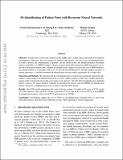| dc.contributor.author | Dernoncourt, Franck | |
| dc.contributor.author | Lee, Ji Young | |
| dc.contributor.author | Uzuner, Ozlem | |
| dc.contributor.author | Szolovits, Peter | |
| dc.date.accessioned | 2017-08-29T19:37:29Z | |
| dc.date.available | 2017-08-29T19:37:29Z | |
| dc.date.issued | 2016-12 | |
| dc.date.submitted | 2016-09 | |
| dc.identifier.issn | 1067-5027 | |
| dc.identifier.issn | 1527-974X | |
| dc.identifier.uri | http://hdl.handle.net/1721.1/111064 | |
| dc.description.abstract | Objective: Patient notes in electronic health records (EHRs) may contain critical information for medical investigations. However, the vast majority of medical investigators can only access de-identified notes, in order to protect the confidentiality of patients. In the United States, the Health Insurance Portability and Accountability Act (HIPAA) defines 18 types of protected health information that needs to be removed to de-identify patient notes. Manual de-identification is impractical given the size of electronic health record databases, the limited number of researchers with access to non-de-identified notes, and the frequent mistakes of human annotators. A reliable automated de-identification system would consequently be of high value.
Materials and Methods: We introduce the first de-identification system based on artificial neural networks (ANNs), which requires no handcrafted features or rules, unlike existing systems. We compare the performance of the system with state-of-the-art systems on two datasets: the i2b2 2014 de-identification challenge dataset, which is the largest publicly available de-identification dataset, and the MIMIC de-identification dataset, which we assembled and is twice as large as the i2b2 2014 dataset.
Results: Our ANN model outperforms the state-of-the-art systems. It yields an F1-score of 97.85 on the i2b2 2014 dataset, with a recall of 97.38 and a precision of 98.32, and an F1-score of 99.23 on the MIMIC de-identification dataset, with a recall of 99.25 and a precision of 99.21.
Conclusion: Our findings support the use of ANNs for de-identification of patient notes, as they show better performance than previously published systems while requiring no manual feature engineering. | en_US |
| dc.language.iso | en_US | |
| dc.publisher | BMJ Publishing Group | en_US |
| dc.relation.isversionof | http://dx.doi.org/10.1093/jamia/ocw156 | en_US |
| dc.rights | Creative Commons Attribution-Noncommercial-Share Alike | en_US |
| dc.rights.uri | http://creativecommons.org/licenses/by-nc-sa/4.0/ | en_US |
| dc.source | arXiv | en_US |
| dc.title | De-identification of patient notes with recurrent neural networks | en_US |
| dc.type | Article | en_US |
| dc.identifier.citation | Dernoncourt, Franck et al. “De-Identification of Patient Notes with Recurrent Neural Networks.” Journal of the American Medical Informatics Association (December 2016): 596–606 © 2016 The Authors | en_US |
| dc.contributor.department | Massachusetts Institute of Technology. Department of Electrical Engineering and Computer Science | en_US |
| dc.contributor.mitauthor | Dernoncourt, Franck | |
| dc.contributor.mitauthor | Lee, Ji Young | |
| dc.contributor.mitauthor | Szolovits, Peter | |
| dc.relation.journal | Journal of the American Medical Informatics Association | en_US |
| dc.eprint.version | Original manuscript | en_US |
| dc.type.uri | http://purl.org/eprint/type/JournalArticle | en_US |
| eprint.status | http://purl.org/eprint/status/NonPeerReviewed | en_US |
| dspace.orderedauthors | Dernoncourt, Franck; Lee, Ji Young; Uzuner, Ozlem; Szolovits, Peter | en_US |
| dspace.embargo.terms | N | en_US |
| dc.identifier.orcid | https://orcid.org/0000-0002-1119-1346 | |
| dc.identifier.orcid | https://orcid.org/0000-0001-6887-0924 | |
| dc.identifier.orcid | https://orcid.org/0000-0001-8411-6403 | |
| mit.license | OPEN_ACCESS_POLICY | en_US |
